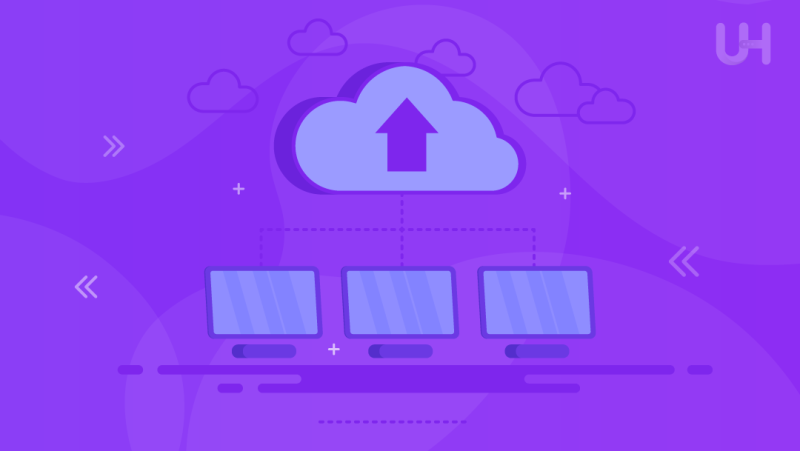Cloud computing is one of the core technologies that define the modern era of digital transformation and innovation in numerous aspects of life. Knowledge about the meaning, functioning, types, and vast possibilities of the cloud is essential to comprehend the essence of contemporary digital realities more fully.
In this article, we provide insights into the nature of cloud computing, focusing on the working principles, types, provided services, and numerous applications for individuals and businesses.
What is Cloud Computing?
The cloud refers to remote servers that may access the Internet and the software and databases they host. Cloud servers are disseminated throughout data centers all around the world. Users and organizations are no longer required to maintain physical servers or install software applications on their local computers as a result of cloud computing.
Since all the processing and storage are done on the servers of the remote data centers, cloud computing allows users to use files and applications through practically any device. Specifically, this means that if your smartphone stopped working and you purchased a new one, you can easily install Instagram and enter your account without any loss of data. The same paradigm applies to cloud–based email platforms like Microsoft Office 365 or Gmail and cloud storage services such as Google Drive or Dropbox.
Moreover, implementing cloud computing allows businesses to eliminate some IT costs and responsibilities. In this regard, the situation changes for businesses that once did not have sufficient funds to purchase and maintain their own servers because “cloud vendors take full responsibility for upgrading and maintaining their servers.”
Similarly, “small businesses can take advantage of cloud computing to eliminate the need for server farms and other data center infrastructure.” The organization can have offices in several countries, and all employees and customers can work with files and applications located in one centralized place.
How Does Cloud Computing Work?

The service models of cloud computing work on the concept of sharing computing resources, software, and data through the internet, which is available on demand. Consumers, who can be individuals or organizations, subscribe to specific resources in the service providers’ virtual pool system, which includes computing power, storage, and networking services produced on the service provider’s remote servers.
Cloud computing has the inbuilt benefit of the pay-per-use feature, meaning that organizations only pay for what they use. Since one is not required to set up and operate their data centers and servers, this technique offers a quick, cost-effective, and easy-to-configure method of expansion.
Cloud computing not only streamlines IT operations but also opens avenues for optimizing financial management in businesses. When considering efficient cloud cost management, exploring various tools is vital. Businesses periodically show keen interest in alternatives to Cloudability which can significantly refine their approach to controlling expenses tied to cloud resource utilization.
To summarize, cloud computing uses a network to which the user is connected to the cloud platform. This is done via the Internet, and on this platform, the user can order and use computing services available for rent. A computer also acts as a semaphore, providing exchange between client devices and cloud servers.
The cloud server provides data exchange and convenient tools with understandable security and data privacy. When it comes to the architecture of cloud computing, there is no right or ideal solution. Each company should do it based on its business needs and challenges. This is another fundamental idea of cloud computing. Therefore, corporations can quickly adapt to the demands of the market or performance indicators.
Types of Cloud Computing
Cloud computing has not only a single form but various models, types, and services, and there isn’t just one to choose from. In reality, a variety of models, types, and services have been created to meet the needs of those using the cloud.
Public Cloud
Public clouds, such as those owned and operated by third-party cloud providers who make computing services such as servers and storage available over the internet, are among the most well-known forms of cloud offerings. A public cloud, such as Microsoft Azure, allows the cloud provider to assume all responsibility for all hardware, software, and other secondary cloud infrastructure. Consumers buy the services, access the account using a web browser, and pay the provider as well. One such example of a public cloud is Microsoft Azure. However, knowledge is required to use such platforms. So, for those exploring Azure services or pursuing related certifications, study materials like AZ-900 Exam Dumps can help build a strong foundation in understanding cloud concepts.
Private Cloud
A private cloud refers to computing resources constructed for a specific enterprise or organization’s use. These resources might be located in the company’s on-site data center or managed in a third-party provider’s data center that hosts the business’s cloud. However, private clouds use a virtualized cluster of imprisoned computing resources separated from other public clouds.
Hybrid Cloud
Hybrid clouds merge public and private clouds and technology that allows them to interact with one another to move programs and data back and forth between the two. The hybrid cloud’s primary benefit is that it offers firms more significant versatility and a wider range of options for where to deploy their applications and data. It can help optimize your existing facilities and increase cloud security and compliance.
Elevate Your Site with Elite Server Hosting!
Are you ready to elevate your online presence? Switch to UltaHost’s server hosting for lightning-fast performance, robust security, and superior scalability, all tailored to your digital requirements.
Services of Cloud Computing
Cloud computing services can be categorized into four main types. They are also colloquially recognized as the cloud computing “stack” because they are compiled in layers. Knowing the finer details of their categorization and relationships may enable you to meet your business goals.
Infrastructure as a Service (IaaS)
IaaS is the most basic category of cloud computing services. Under this service, you acquire the IT infrastructure from a cloud provider and pay for what you use. Infrastructure as a Service provides virtual machines, servers, storage, and networks. For example, you can use virtual machines and manage the OS up to the self-service portal.
Platform as a Service (PaaS)
Platform as a Service encompasses cloud computing services that deliver an on-demand platform for developing, testing, delivering, and managing software applications. The aim of PaaS is to aid developers so that they can develop web or mobile applications and do not need to configure or manage the underlying infrastructures—such as the network, storage, server hosting, and database—required to design them.
Software as a Service (SaaS)
SaaS is the distribution of software applications over the Internet, usually via the subscription model. SaaS cloud providers host and manage the software application and the support infrastructure. They are responsible for software upgrades and security support. End-users access the software via a web browser on their devices, such as smartphones, tablets, or PCs.
Serverless Computing
Serverless computing, which overlaps with PaaS, aims to focus on developing and adding application functionality without continuously managing servers and infrastructure. The cloud provider is responsible for setting up, planning for capacity, and maintaining servers. Serverless architectural patterns are designed to increase flexibility and use resources twice as much as possible only when a particular function is not active or is triggered.
Benefits of Cloud Computing

Although in traditional on-premises IT setups, firms have to own and manage physical data centers and servers to acquire computing power, data storage, and other resources, cloud computing has several advantages. Some of the most notable advantages include the following:
Cost Efficiency
Achieving cloud reduces the cost-effectiveness of buying, installing, deploying, and supporting mainframe computers as well as on-premises infrastructure. As a result, you only compensate for the cloud-based infrastructure and computing resources you utilize. This gives you the option to invest in cloud web hosting for better performance, reliability, and flexibility in managing your online presence. For businesses focused on managing cloud costs more effectively, using purpose-built FinOps software can significantly enhance visibility and control over their cloud spending.
Speed and Flexibility
Cloud computing allows businesses to immediately access enterprise applications. In the absence of cloud computing, the procurement and installation of supporting hardware and software could take weeks or even months for IT personnel to satisfy the request. This agility allows users of the cloud, particularly developers and DevOps organizations, to make better use of cloud-based software and infrastructure.
Limitless Scalability
Whether your business is growing or fluctuating, cloud computing provides rapid elasticity and self-service demand. Rather than investing large sums of cash in high capacity and then leaving it idle during slow periods, opt for maximum capacity during high demand. On the other hand, when demand goes down, you would not like to bear the cost of extra capacity. Additionally, the cloud offers access to the provider’s network, enabling you to place applications next to the worldwide user base.
Increased Strategic Value
The ultimate goal of investing in cloud computing is not just to be part of digital transformation but to connect the organization to all seasons. For example, in a retail or financial organization, deploying generative Artificial Intelligence in the cloud can increase virtual customer service speed and unconsciously enable the team to focus on more profitable ventures. Cloud-based software can help teams work together and focus on timely data to monitor a manufacturing process’s logistics and supply chain.
Conclusion
Cloud computing is a fundamental technology shaping our digital world. By now, you’d have explored cloud computing’s essence, from definitions to applications, highlighting its role in innovation and transformation. Understanding the cloud’s workings, types, and services is key to navigating today’s digital landscape. For businesses attempting to maintain a competitive edge and improve their operational flexibility, the adoption of cloud computing technology remains a critical aspect. At this rate of evolution in the digital platform, cloud computing can help organizations stay ahead and remain relevant in the competitive market.
Seamless integration and reliable support are paramount in cloud computing. UltaHost offers top-tier Cloud Storage VPS solutions, ensuring your data remains secure and accessible across all platforms. Elevate your cloud computing experience today!
FAQ
Can cloud computing be customized for businesses?
Yes, cloud services are highly customizable to meet specific business needs, allowing for scalability, integration, and enhanced security measures.
Which industries benefit most from cloud computing?
Cloud computing benefits various industries, including healthcare, finance, and manufacturing, by improving data management, collaboration, and operational efficiency.
How does cloud computing handle data privacy and compliance?
Cloud providers prioritize data privacy and compliance, implementing robust measures to protect sensitive information and adhere to industry regulations.
Can cloud computing assist startups and small businesses?
Absolutely! Cloud computing offers startups and small businesses affordable access to enterprise-grade infrastructure, enabling rapid scalability, reduced upfront costs, and increased focus on innovation.
What’s the role of artificial intelligence in cloud computing?
AI integration enhances cloud services with predictive analytics, natural language processing, and automation, empowering tasks like data analysis, customer service, and resource optimization.








